Blue Jays free agency: High-level relief options and likelihoods


The Toronto Blue Jays have three members of their 2016 season-end bullpen entering free agency this offseason
The MLB free agent period officially opens when the clock turns to Tuesday, and the Toronto Blue Jays have some work to do.
The trio of Brett Cecil, Joaquin Benoit, and Scott Feldman are hitting free agency this offseason, leaving the Blue Jays without their top left-hander, a dominant late-inning veteran, and their long man from the end of the 2016 season. It’s also looking like Joe Biagini will audition as a starter this spring, potentially eliminating another key bullpen cog.
If the season were to start today, closer Roberto Osuna would be joined by Jason Grilli, whose $3 million option for 2017 was picked up by the Blue Jays on Friday. Aaron Loup is projected to earn $1.2 million in arbitration according to MLBTR, leaving he and a group of inexperienced left-handers as the only southpaw options. The Blue Jays need to add, but how big a splash are they willing to make?
Only four teams in baseball got more mileage out of their starting rotation than the Blue Jays in 2016. Houston, who ranked first, had just 8.2 more innings from starters than Toronto. That may not be sustainable, and striking gold in the Rule 5 draft is not an annual event. Toronto was also very fortunate to buy low on Grilli and Benoit at the perfect time, so there’s a strong argument to be made that they’ll need to prepare themselves better than in 2016.
The recent MLB playoffs — at times known as the Festival of Andrew Miller — again highlighted the value of teams using their best relievers in the highest-leverage spots, not just in the ninth inning. Now more than ever, “closer money” will be spent on non-closers.
Ahead, we’ll examine relievers who are in, or near, the top-50 available free agents and could conceivably earn a multi-year deal. This isn’t to say they are likely to be in blue and white by the end of November, but these are the names you can expect to hear ad nauseam in the coming weeks.
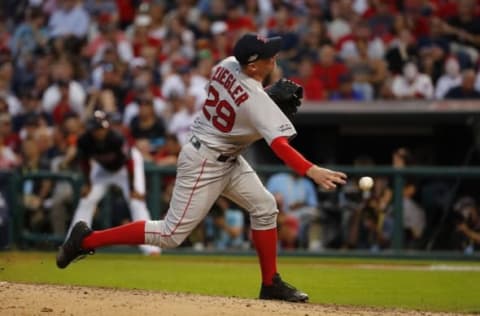
RHP Brad Ziegler – 37 years old
2016: Arizona Diamondbacks, Boston Red Sox
Brad Ziegler has long been one of the game’s more underrated relief options, and for the first time as a major leaguer, he’ll have the opportunity to test free agency.
After emerging late with the Oakland Athletics as a 28-year-old in 2008, Ziegler was traded to the Diamondbacks in 2011. This past July, Arizona dealt him to the Boston Red Sox in exchange for Jose Almonte and Luis Alejandro Basabe.
Ziegler, who throws submarine-style, succeeded as the Diamondbacks’ closer for the majority of the past two seasons. That success translated directly to the Red Sox and the American League East playoff race, too, where the veteran posted a tidy 1.52 ERA over 29.2 innings.
Provided by Baseball-Reference.com: View Original Table
The Blue Jays and Ziegler align especially well due to his pitching style, which produces a very high rate of ground balls. Toronto’s left side of Josh Donaldson and Troy Tulowitzki is defensively elite, while Devon Travis provides an underrated glove at second. In full innings, or when used situationally with a runner on base, Ziegler’s ability to keep the ball on the ground could be even more valuable in Toronto than on the average team.
Ziegler forced ground balls at a rate of 63.3% in 2016, down from 72.8% the year prior but still a very strong number. That number does tend to fluctuate slightly in line with his strikeout rate. Over the past four seasons, Ziegler has posted a ground ball rate over 70% with a strikeout rate under 5.00 per nine innings twice. The other two seasons, that strikeout rate climbed over 5-per-9 which limited his grounders.
His sinking fastball averages just 84 miles-per-hour, but Ziegler’s combination of movement and release point leads to success. Ziegler also throws a curveball and changeup, which is a very rare pitch to see from a submarine-style reliever.
Age is a question with Ziegler, as it is with any relief pitcher over 30. His pitching style makes it a far lesser issue, of course, but a two-year deal would take him through his age-39 season. Expect Ziegler to earn something in the neighbourhood of $6.5-8.5 million annually.
Likelihood: Fairly reasonable, given that most contending teams will view Ziegler as a seventh or eighth-inning option.
Next Up: The market’s third-best closer still offers top-level value

RHP Mark Melancon – 31 years old
2016: Pittsburgh Pirates, Washington Nationals
In any other offseason, Melancon would be the number one relief option on the open market. This year, however, he’s widely considered to be option number three behind Jansen and Chapman.
That shouldn’t be seen as a knock on Melancon, though, as he remains one of the most dominant closers in all of baseball. After putting up 51 saves with a 2.23 ERA in 2015, the right-hander followed it up with 47 more saves and an excellent 1.64 ERA this season.
Provided by Baseball-Reference.com: View Original Table
Of benefit to Melancon’s free agency is the fact that he was traded in-season from Pittsburgh to Washington for Taylor Hearn and Felipe Rivero. That deal negates the possibility of Melancon being issued a qualifying offer, freeing his market up with no draft pick being attached to his name.
Melancon has been worth at least 1.5 Wins Above Replacement (FanGraphs) over the past four seasons with a ground ball percentage typically in the high-50s. His average velocities actually took a (very) small step forward this year from 2015, which was a year of slight regression. His batted ball metrics remain consistent as well, and his cutter is as strong as ever, so Melancon is showing no signs of slowing.
There are certainly a lot of recent innings on Melancon’s arm, however, as he’s averaged 74 appearances annually for the past four years. The early 30s are typically where high-use relievers begin to battle regression — some even earlier — so Melancon does come with a sliver of risk, especially at the back end of his contract.
This is likely to keep him just below the contract length that Jansen or Chapman are likely to receive.
Anyone of Melancon’s calibre is also an unnatural fit in the Blue Jays bullpen with the presence of Osuna. The 21-year-old held off Drew Storen in spring training 2016, but a reliever like Melancon is a different situation altogether.
In a game of hypotheticals, Osuna would be the one to move into a more flexible, high-leverage role with Melancon taking over the traditional role of closer, but that introduces some moving parts to the equation.
Likelihood: As likely as Dioner Navarro stealing second base on Ivan Rodriguez.
Next Up: A lefty-killer and World Series champ
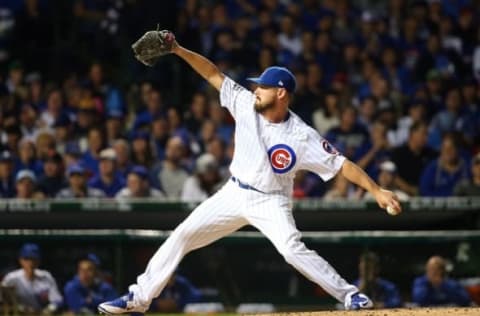
LHP Travis Wood – 29 years old
2016: Chicago Cubs
Wood’s free agency could go in several different directions, and the first question that needs to be answered is whether he’ll be hitting the market as a starting pitcher or a reliever.
Working as a near full-time reliever in 2015 and 2016 (he made nine starts in ’15), Wood has really found a niche as a left-on-left specialist with the World Series Champion Chicago Cubs.
As recently as 2014, though, Wood was a full-time rotation piece. In 2013 he was named an All-Star, posting a 3.12 ERA over 200.0 innings pitched.
Provided by Baseball-Reference.com: View Original Table
Wood’s lefty-righty splits will be a primary bargaining chip for him when the market opens. In 2015, he held left-handers to a .597 OPS compared to a .698 mark against right handers.
This year, his dominance against left-handers placed him as one of the game’s best in that area, holding them to a .447 OPS over 120 plate appearances. His .865 OPS against righties was problematic, however, and that will need to drop in order for Wood to become a more well-rounded bullpen option.
His 2.95 ERA in a relief role these past two seasons sets Wood up for a multi-year deal, but he could be viewed as anything from a depth starter to a high-end lefty specialist. To Toronto, his best fit would be in a middle-relief role with a heavy left-hand focus. Something like what Aaron Loup offered the team when he was at his best three years ago.
The Rogers Centre may not be a great fit for Wood, however, being a fly ball pitcher who allows his fair share of hard contact. He leans heavily on his hard stuff, mainly a fastball and cutter, and he could benefit from one of his secondary offerings stepping forward as a true wipeout pitch.
Lefty relief is one of Toronto’s biggest voids, though, so expect to hear them linked to several options at the position. If there’s belief that Loup can rebound as a specialist, however, there would need to be a belief that Wood could become more well-rounded for the Jays to have legitimate interest.
Likelihood: Conceivable, but don’t buy the jersey just yet.
Next Up: A veteran closer with gas in the tank
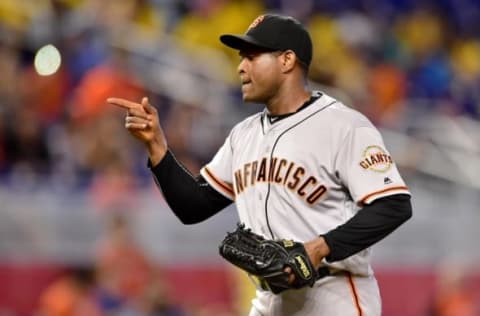
RHP Santiago Casilla – 36 years old
2016: San Francisco Giants
Casilla’s name is buried behind Chapman, Jansen, and Melancon in this free agent class, but he’s a perfectly capable option for teams looking to solidify the back end of their bullpen.
The 36-year-old Dominican has 88 saves over the past three seasons with the San Francisco Giants, and a relatively poor 2016 season represented his first ERA over 2.85 since 2010. That was Casilla’s first year in San Francisco after coming over from the Oakland Athletics as a struggling reliever.
Provided by Baseball-Reference.com: View Original Table
The big question facing Casilla in free agency is whether his moderate regression in 2016 was a blip on the radar or a sign of something larger in his 13th MLB season. Besides, back-end relievers in their late-30s don’t have the most reliable track record.
One area that hurt Casilla in 2016 was home runs. The eight he allowed tied a career high, and if his 1.2 home runs per nine innings drops back down to his career average (0.8), his ERA begins to normalize rather quickly. Casilla’s fly ball percentage and hard contact percentage both grew in 2016 compared to recent averages, so there’s a chance those are merely outliers.
Casilla’s velocity stayed true in 2016, so there are not any signs of arm fatigue at this point. When he’s at his best, Casilla pounds the zone with a two-seam fastball and attacks hitters with a plus curveball. He’s also capable of a ground ball rate above 50%, which brings value in a defensively strong Blue Jays infield.
In the context of Toronto, Casilla — and most other high-quality right-handers — would be brought in to fill the Joaquin Benoit role from 2016. A trusted, veteran presence for manager John Gibbons that allows him to be as flexible as possible with Osuna, Grilli, and his left-handers.
Casilla won’t quite reach the years or dollars of the closers at the top of the market, but a comfortable two-year deal is easy to envision. His choice will come between closing for a mid-level team or setting up for a contender.
After the big three names fall off the board, Casilla could also represent ‘Plan B’ for several teams. In that scenario, it’s possible that his price tag gets a sudden jolt as front offices scramble to leave free agency with something in their ‘pen.
Likelihood: Heavily dependant on his market, but Toronto has had luck with grizzled righties…
Next Up: A Pirates reclamation project? You don’t say…
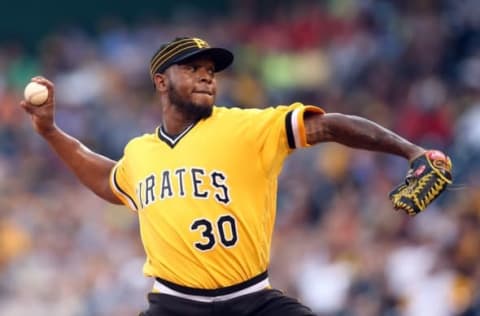
RHP Neftali Feliz – 28 years old
2016: pittsburgh Pirates
It’s been a long road for Neftali Feliz, who broke in as a 21-year-old and one of the top prospects in all of baseball with the Texas Rangers in 2009.
Feliz earned Rookie of the Year honours in 2010, saving 40 games in 70 appearances and dazzling with his high-velocity arm. Entering 2012, Feliz remained one of the best young relievers in all of baseball, but the Rangers pushed their luck.
Texas transitioned Feliz into the starting rotation and it wasn’t long until he went under the knife for the dreaded Tommy John surgery. He returned in late 2013 and showed encouraging signs in 2014, but the 2015 season saw him completely bottom out in a year split between Texas and Detroit.
It all turned around in Pittsburgh, though (J.A. Happ and Francisco Liriano nod approvingly). Feliz’s statistics rebounded and, more importantly, his velocity returned.
Provided by Baseball-Reference.com: View Original Table
Feliz still needs to be viewed as a work in progress in this conversation. His 2016 statistics alone don’t paint him as an excellent reliever, but if they’re viewed as a strong step toward a strong career rebuild, there’s really something to like.
His 10 home runs allowed were very problematic (1.7 per nine innings), and would not fit well in the Rogers Centre. Such a number should normalize, however, as Feliz readjusts to his velocity and hones in his control again. Even with his 10.2 strikeouts per nine innings, FanGraphs valued Feliz as being worth -0.1 Wins Above Replacement.
The right-hander leans heavily on a fastball-slider combination, though his slider now comes at a higher velocity than his younger years in Texas. Improving on that slider and finding better fastball control will be the keys to Feliz reestablishing himself as a high-leverage reliever.
Given his age and upside, Feliz is likely to receive a two-year deal in free agency, perhaps an option year in year two given his unpredictable nature. Will Toronto have the risk appetite necessary to roll the dice on him?
The in-season additions of Grilli and Benoit proved that, in the right circumstances, Toronto’s new front office is very willing to accept risk. Their internal opinion on Feliz is an unknown variable, but at the very least, there is not a complete aversion to these cases.
If the right team adds Feliz, they could catch lightning in a bottle. Maybe.
Likelihood: Realistic as a secondary option
Next Up: Sergio. No relation to Tony.
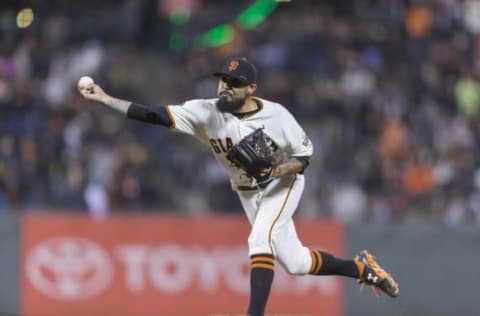
RHP Sergio Romo – 33 years old
2016: San Francisco Giants
This isn’t the same Sergio Romo that saved 38 games and earned an All-Star nod with the Giants in 2013, but if he’s healthy, he may not be far off.
Romo missed a significant portion of 2016 recovering from a flexor strain in his right elbow. It began as arm fatigue early in the season as his velocity dipped, but further testing revealed no structural damage.
A pair of rough playoff outings against the Chicago Cubs in the NLDS ended his season on a sour note, but the veteran still managed to put up some nice regular season numbers over his 40 appearances.
Provided by Baseball-Reference.com: View Original Table
The end result of 2016 had Romo being valued at 0.2 Wins Above Replacement after values of 1.1 or higher in six of the last seven seasons.
His surface level stats and ratios remained quite strong, though. Romo has always brought excellent control to his late-inning role and continued that by walking just 2.1 batters per nine innings. He also consistently manages to turn his relatively low velocities into some high strikeout totals.
Home runs have become an issue in two of the past three seasons for Romo. His career average of allowing 0.8 per nine innings is manageable, but 1.4-1.5 isn’t.
Romo’s sinker-slider mix leans more heavily towards the slider, but his velocity did creep back across the board this year. Both of his primary pitches lost about 1.5 MPH, bringing his average “hard stuff” down to 86.0 MPH. Romo has always been a reliever that succeeds in spite of his uncommon power, but unless that bounces back, it could become more difficult.
Next: Jays offseason an educated marathon, not a blind sprint
Much like his teammate Casilla, Romo would fill a similar role on the Blue Jays to Benoit in 2016. He’s been especially strong against right-handers in his career, though, so some strong bullpen management could really squeeze the maximum remaining value out of him.
Caution over his elbow might rob Romo of a guaranteed second year, but a low-risk option year might appeal to some teams. All it takes is one front office to believe in his elbow, though.
Likelihood: Unlikely given risk of regression